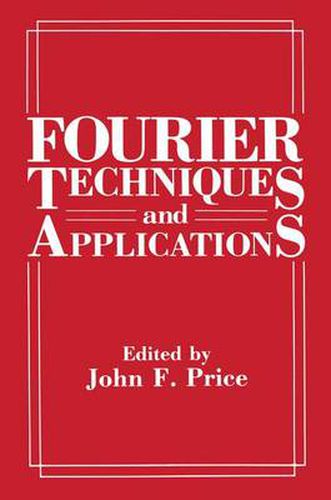Readings Newsletter
Become a Readings Member to make your shopping experience even easier.
Sign in or sign up for free!
You’re not far away from qualifying for FREE standard shipping within Australia
You’ve qualified for FREE standard shipping within Australia
The cart is loading…






This title is printed to order. This book may have been self-published. If so, we cannot guarantee the quality of the content. In the main most books will have gone through the editing process however some may not. We therefore suggest that you be aware of this before ordering this book. If in doubt check either the author or publisher’s details as we are unable to accept any returns unless they are faulty. Please contact us if you have any questions.
The first systematic methods of Fourier analysis date from the early eighteenth century with the work of Joseph Fourier on the problem of the flow of heat. (A brief history is contained in the first paper.) Given the initial tempera ture at all points of a region, the problem was to determine the changes in the temperature distribution over time. Understanding and predicting these changes was important in such areas as the handling of metals and the determination of geological and atmospheric temperatures. Briefly, Fourier noticed that the solution of the heat diffusion problem was simple if the initial temperature dis tribution was sinusoidal. He then asserted that any distri bution can be decomposed into a sum of sinusoids, these being the harmonics of the original function. This meant that the general solution could now be obtained by summing the solu tions of the component sinusoidal problems. This remarkable ability of the series of sinusoids to describe all reasonable functions, the sine qua non of Fourier analysis and synthesis, has led to the routine use of the methods originating with Fourier in a great diversity of areas - astrophysics, computing, economics, electrical engineering, geophysics, information theory, medical engineering, optics, petroleum and mineral exploration, quan tum physics and spectroscopy, to name a few.
$9.00 standard shipping within Australia
FREE standard shipping within Australia for orders over $100.00
Express & International shipping calculated at checkout
Stock availability can be subject to change without notice. We recommend calling the shop or contacting our online team to check availability of low stock items. Please see our Shopping Online page for more details.
This title is printed to order. This book may have been self-published. If so, we cannot guarantee the quality of the content. In the main most books will have gone through the editing process however some may not. We therefore suggest that you be aware of this before ordering this book. If in doubt check either the author or publisher’s details as we are unable to accept any returns unless they are faulty. Please contact us if you have any questions.
The first systematic methods of Fourier analysis date from the early eighteenth century with the work of Joseph Fourier on the problem of the flow of heat. (A brief history is contained in the first paper.) Given the initial tempera ture at all points of a region, the problem was to determine the changes in the temperature distribution over time. Understanding and predicting these changes was important in such areas as the handling of metals and the determination of geological and atmospheric temperatures. Briefly, Fourier noticed that the solution of the heat diffusion problem was simple if the initial temperature dis tribution was sinusoidal. He then asserted that any distri bution can be decomposed into a sum of sinusoids, these being the harmonics of the original function. This meant that the general solution could now be obtained by summing the solu tions of the component sinusoidal problems. This remarkable ability of the series of sinusoids to describe all reasonable functions, the sine qua non of Fourier analysis and synthesis, has led to the routine use of the methods originating with Fourier in a great diversity of areas - astrophysics, computing, economics, electrical engineering, geophysics, information theory, medical engineering, optics, petroleum and mineral exploration, quan tum physics and spectroscopy, to name a few.